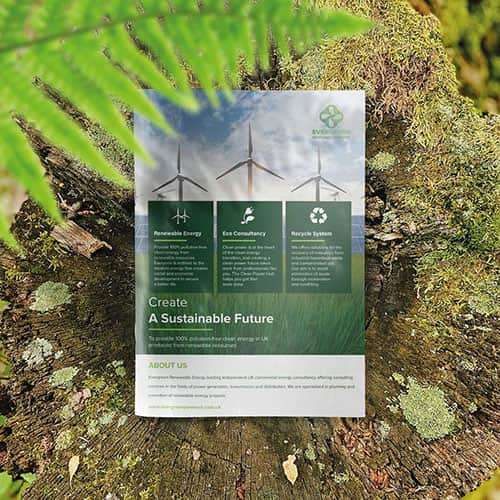In a world that’s becoming more environmentally conscious by the day, every choice we make, even in print, has an impact. Whether you’re a small business, a designer, or a marketing professional, switching to eco-friendly printing materials is one of the simplest yet most effective ways to reduce your carbon footprint without compromising quality or creativity.
With growing awareness around sustainability, consumers are actively supporting brands that make greener choices. But the world of eco-conscious printing can feel like a maze with terms like biodegradable print materials, soy-based inks, and carbon-neutral printing being thrown around. So, how do you make the right choice?
At Printingprogress Ltd, we believe in print with purpose. From recyclable print products to non-toxic printing processes, we help businesses bring their ideas to life while protecting the planet. Get in touch today to discover stylish, simple, innovative, and sustainable printing services.
Call us on 0800 999 1094 or email us at info@printingprogress.co.uk today!
At Printingprogress Ltd, we combine creativity with conscience through eco-friendly printing materials. From sustainable designs to planet-friendly finishes, we help your brand make a bold impression without leaving a heavy footprint.
7 Tips For Choosing Eco-Friendly Printing Materials
1. Choose Sustainable Printing Materials That Are Responsibly Sourced
The first step in greener printing is choosing sustainable materials, which begins with understanding where your materials come from. Look for paper and card stock certified by organisations like the FSC (Forest Stewardship Council) or PEFC, which ensure materials come from responsibly managed forests.
These certifications don’t just protect trees. They also support ethical labour and biodiversity in forest communities. Many of these papers are also chlorine-free and made with reduced water and energy consumption.
Tip: Ask your printer if they stock eco-certified paper ranges and request paper made from 100% post-consumer recycled content for maximum sustainability.
2. Use Recycled Paper For Printing To Reduce Waste
Using recycled paper for printing is one of the most impactful and accessible choices. It helps lower deforestation, conserves energy, and keeps usable material from landfills.
Modern recycled paper is no longer rough or grey — it’s available in premium finishes that rival virgin paper in quality. You can find recycled stocks in glossy, matte, textured, and uncoated styles suitable for everything from business cards to luxury brochures.
Why it matters: Producing recycled paper uses up to 50% less energy and water than producing new paper from raw pulp.
3. Choose Environmentally Friendly Inks Over Petroleum-Based Alternatives
Most conventional inks are made from petroleum and contain volatile organic compounds (VOCs) that pollute the air and pose health risks. Environmentally friendly inks, such as soy- or vegetable-based inks, offer a safer, greener solution.
Not only are they biodegradable, but they also produce more vibrant colours and make paper easier to recycle during the de-inking process. This is especially important for printed products destined for the recycling bin.
Look out for: Inks labelled low-VOC, water-based, or non-toxic printing options for safer results.
4. Prioritise Green Printing Options With Low-Impact Technology
Today’s print technology offers a variety of green printing options that significantly reduce environmental impact. From digital printing (ideal for short runs) to on-demand printing, there are more innovative ways to print what you need and when needed.
These low-impact printing processes use less ink, energy, and waste, eliminating the need for setup materials like printing plates or chemical developers used in traditional offset printing.
Ask your printer about:
- Duplex printing (double-sided)
- Waterless printing technology
- Short-run digital printing to avoid overproduction
5. Use Biodegradable Print Materials And Compostable Packaging For Disposable Items
For items that won’t be kept long, like food menus, shipping labels, or packaging, opt for biodegradable print materials that safely break down in compost or landfill environments.
Pair these with compostable packaging from cornstarch, sugarcane bagasse, or bamboo. Unlike plastic, these materials don’t leave behind harmful microplastics.
Bonus: Biodegradable and sustainable packaging options are a great way to show customers that your brand is serious about sustainability.
6. Choose Reusable Materials Where Possible
Not everything you print has to be disposable. Choosing reusable materials like washable banners, reusable signage, or PVC-free fabric displays is a smart way to reduce repeat print orders and minimise waste.
This is especially relevant for event marketing, trade shows, or seasonal promotions. By designing pieces that can be used multiple times, you stretch your investment further and reduce your environmental impact.
Think long-term: Reusable display materials can be stored and refreshed as needed, reducing design and production costs.
7. Work With A Printer Offering Sustainable Print Solutions
Finally, your green printing journey is only as intense as your printing partner. Work with a company that offers full-spectrum sustainable print solutions from eco-friendly substrates and environmentally friendly inks to energy-efficient production methods and carbon-neutral printing options.
Look for printers who offset emissions, recycle offcuts, and invest in climate-friendly print practices as part of their business model. Transparency matters; your printer should be proud to share its green credentials.
Pro tip: When choosing a print provider, ask for a sustainability statement or environmental policy.
CONTACT PRINTINGPROGRESS
Conclusion
The printing world is changing, and making sustainable choices isn’t just better for the planet and business. By using eco-friendly printing materials, your brand stands for something bigger: responsibility, innovation, and a vision for a greener future.
Whether switching to recycled paper for printing, choosing non-toxic printing inks, or investing in reusable materials, every decision helps reduce your impact and shows your customers you care.
At Printingprogress Ltd, we’re proud to lead the way in eco-conscious printing. Our expert team offers personalised support, ethical sourcing, and beautiful results wrapped up in a commitment to the environment.
Contact us to create high-impact print with a low environmental footprint.


 Eco friendly, sustainably sourced recycled FCS certified print
Eco friendly, sustainably sourced recycled FCS certified print Takeaway Screens
Takeaway Screens Postal Boxes
Postal Boxes